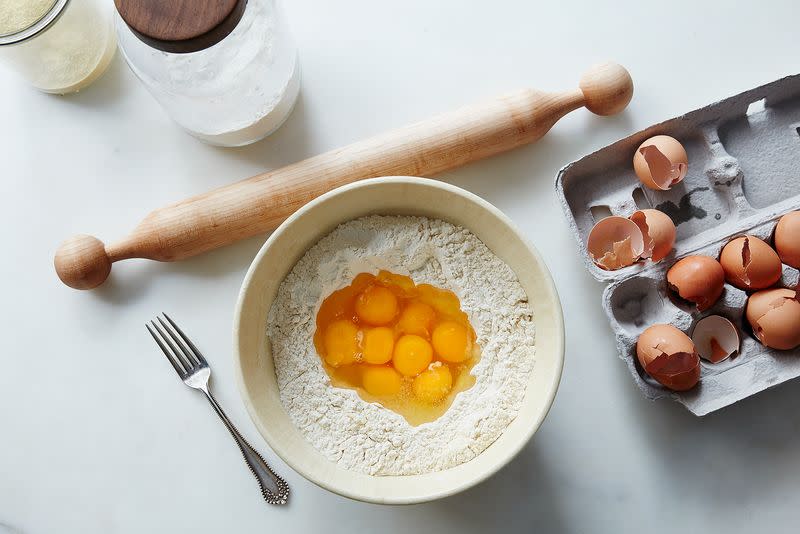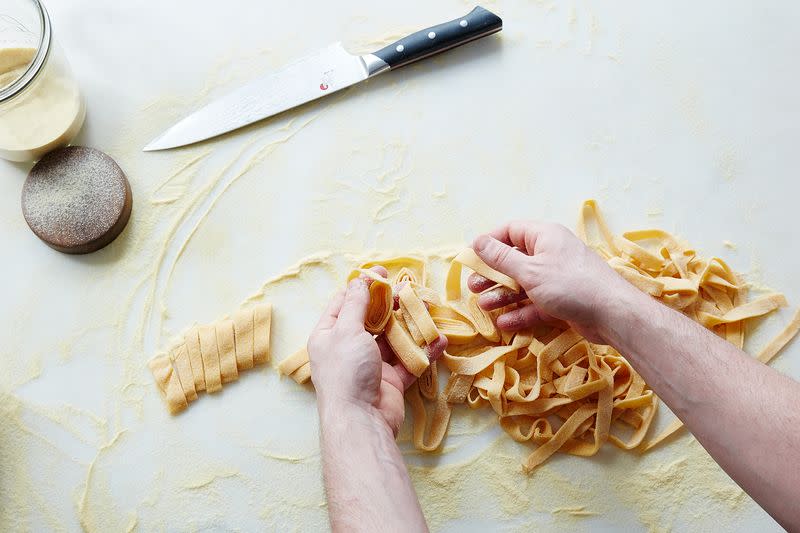How to make fresh pasta dough like a chef

If someone asks me about the quantities in my pasta dough recipe, I enjoy yelling "Quanto Basta!" and grinning. The phrase means "until it's enough"—it's the way I wish I could answer most culinary questions.
Take pleasure in the fact that our hands have memories—they'll remember the texture of perfect pasta dough and alert us if the dough is too wet or must be kneaded for longer.
But don't worry if your hands don't know pasta dough yet. The dough is forgiving, and you'll learn quickly. Even if you have no idea what you're doing, your first try at making pasta will yield some sort of noodle. Creating pasta from nothing more than flour and eggs is a true delight.
Here's how to make pasta dough with your senses, not numbers:
Add flour to a large mixing bowl.
You could use all-purpose flour, but I prefer to use Italian 00 flour, which is ground extra fine and gives the pasta a silky, soft texture. I usually add 1 part semolina flour to 3 parts Italian 00 flour. The semolina adds a texture to the finished pasta that's usually referred to as al dente. But if you prefer a more silky bite of pasta, use less semolina, and if you want more bite, use more.
How much flour should I add? How many eggs should I get ready?
Quanto Basta! (But, if you really need a more specific answer, you can count on using approximately 1 egg and 100 grams of flour per person.)

Crack some eggs.
Make a well in the center of your flour. Make it look like a volcano. Crack eggs into the center of the volcano. Here's an important trick: *When your eggs nearly reach the top of your mound of flour, you've added enough eggs.
Sometimes I add extra yolks to my pasta because they're rich and fatty and add a density to the finished dough. You can experiment with different combinations of egg whites and yolks in your dough and determine what you like best—there are no wrong answers. The egg whites have a high water content, and they will give your dough a softer texture.
Make dough!
Using a fork, beat the eggs in the center of the flour, then slowly bring flour into the egg mixture. When almost all of the flour has been mixed in with the eggs, discard the fork and use your hands. Gather the dough into a ball and knead the dough inside the bowl for about a minute. The dough should feel wet and tacky. For now, this is good. You can always add more flour to a wet pasta dough, but once your dough becomes too dry, any attempt at rehydrating it usually ends in a gummy lumpy mess.
Transfer the dough onto a clean surface. Leave the dried bits of dough and trace amounts of extra flour in the mixing bowl. Wash your hands. Start fresh.

Knead the dough.
Knead the dough and add flour as necessary until the dough is no longer tacky. If you can knead the dough without it sticking to your hands, you have added the correct amount of flour.

Pause early in the kneading process and slowly stretch the dough apart in your hands. The dough will appear to tear and pull apart from itself. After approximately 10 minutes of continuous kneading, if you stop and try again to slowly pull the dough apart, you should notice that the dough stretches without tearing as much. The dough should also appear smoother, sleeker, and more homogeneous. These are indications that you have kneaded the dough enough.


Top: early in the kneading process; bottom: when the dough is fully kneaded. Photos by James Ransom, James Ransom
Give it a rest.
The final step is to let the dough rest. Cover it tightly in plastic wrap, and leave it out at room temperature for at least 30 minutes. If you knead your dough properly and let it rest for at least 30 minutes, it will be easy to roll out. If you skimp on either of these steps, you may have trouble rolling out your dough.
Roll it out.
No matter what tool you use to roll out your dough, remember to have some extra flour nearby to make sure your pasta does not stick to the countertops or to itself. Lightly dust the pasta as you work. There are a few ways to roll out the dough:
Rolling pin: The one shown above is going to be available in The Food52 Shop soon, and we're really excited about it! The goal is to make your pasta as thin and delicate as possible. It can be hard to do—but experience will get you there.
Hand crank: This is an affordable, reliable way to roll out the dough. It can get the dough very thin. This is what I use at home.
Kitchen Aid mixer attachment: This is what I use at work. It's fast and efficient and electric so you can use two hands to pass the dough through the machine and catch it (unlike the hand crank, which requires you to crank with one hand and manipulate the dough with your other hand).
A luxurious option: This electric machine is expensive and large but it is easy to use. I see this type of machine in serious restaurants where they make pasta for 200 people per night. It's a pleasure to use this machine, but in no way necessary.
Make noodles.
Roll the dough up so it looks like a log. Using a sharp knife, cut the dough into ribbons. Spread the ribbons apart with your fingers—they unravel to become noodles.
Most pasta rollers (the hand crank and the Kitchen Aid attachment) will come with an add-on attachment that will cut a sheet of pasta into noodles. When I roll dough with a rolling pin, I cut the noodles with a knife.

More from Food52:
Is There a "Right" Way to Roast Vegetables?
The Best Way to Store All Sorts of Flours
5 Alternative Vinegars That Will Brighten Your Pantry
My Week of Waste-Free Cooking (& How You Can Do It, Too)






